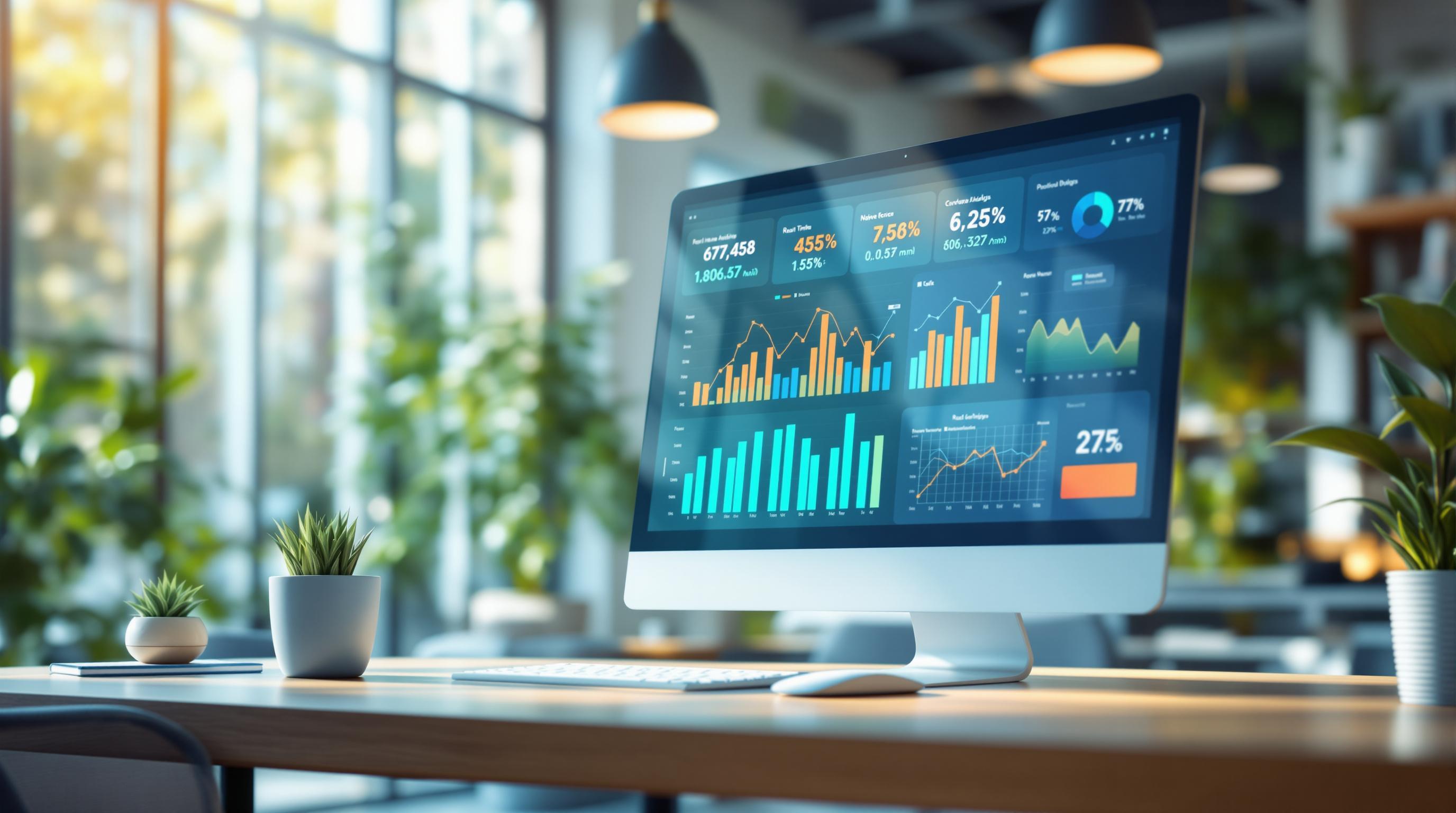Security reporting in analytics is about tracking and analyzing data to protect sensitive information and prevent breaches. It helps businesses manage risks, meet regulations, and improve processes.
Key Highlights:
- Core Focus: Monitoring user access, data handling, system integrity, and detecting threats.
- Business Benefits: Better data protection, regulatory compliance, operational efficiency, and cost reduction.
- Main Goals:
Tools & Techniques:
- AI Tools: Detect threats, predict risks, and automate responses.
- Data Visualization: Use dashboards for real-time monitoring and compliance tracking.
Steps to Get Started:
- Set up data governance.
- Use tools for real-time threat detection.
- Centralize reporting for better visibility.
- Conduct regular audits and updates.
Security reporting is essential for protecting analytics platforms and ensuring compliance. Start by gathering accurate data, monitoring key metrics, and using AI-powered tools to stay ahead of risks.
Core Security Reporting Elements
Data Collection Methods
Security reporting starts with gathering accurate and relevant data. Modern analytics platforms use several methods to collect security-related information:
Automated Log Collection
- System logs that track user activity, authentication attempts, and data access
- Monitoring APIs for third-party integrations
- Analyzing network traffic to identify patterns
- Real-time event streaming for immediate threat detection
Data Standardization
Collected data is often organized into categories like:
- Authentication logs
- Security incidents
- Compliance violations
This standardized data forms the foundation for the metrics discussed below.
Key Security Measurements
Once the data is collected, the next step is to focus on specific metrics that indicate system health and potential threats. Here are some critical metrics to monitor:
| Metric Category | Key Indicators | Measurement Frequency |
|---|---|---|
| Access Security | Failed login attempts, Password resets, Session duration | Real-time |
| Data Protection | Encryption status, Data access patterns, Permission changes | Daily |
| System Health | Patch status, Update compliance, Configuration drift | Weekly |
| Incident Response | MTTD (Mean Time to Detect), Resolution time, Incident severity | Monthly |
Meeting Compliance Standards
Structured security reports are essential for meeting compliance requirements and building trust in your analytics operations.
1. SOC 2 Compliance
SOC 2 reports should cover controls related to security, availability, processing integrity, confidentiality, and privacy. Key areas to include:
- Access control systems
- Data encryption status
- Change management processes
- Incident response protocols
2. ISO 27001 Requirements
ISO 27001 compliance focuses on:
- Documenting risk assessments
- Evaluating the effectiveness of security controls
- Results from continuous monitoring
- Regular security reviews
3. Industry-Specific Regulations
Different industries have unique compliance needs. For example:
- Healthcare: HIPAA-compliant reports should include PHI access logs, security incident tracking, and business associate compliance.
- Financial Institutions: Reports must align with PCI DSS, GLBA compliance, transaction monitoring, and fraud detection metrics.
Data integration platforms can simplify compliance by consolidating these requirements into unified dashboards, making it easier to manage and demonstrate adherence to multiple standards.
Security Reporting Guidelines
Team Training Requirements
For security reporting to be effective, teams must be equipped with the knowledge and skills to create, analyze, and act on these reports.
- Core Skills
- Learn the structure and key elements of security reports.
- Understand incident response procedures to take immediate action when needed.
- Stay informed about compliance requirements to meet industry standards.
Both individual skills and teamwork are crucial for effective reporting.
- Interdepartmental Collaboration
- Analytics teams should focus on interpreting security metrics and spotting irregularities.
- Security teams must excel in detecting threats and executing response protocols.
- Management should understand risk assessment methods and the compliance impact of security incidents to make informed decisions.
Real Time Reporting for Continuous Compliance and Risk
sbb-itb-5174ba0
Third-Party Security Reviews
Independent reviews go beyond internal controls, offering an extra layer of external validation for your security measures.
Why External Reviews Matter
Third-party security reviews provide an unbiased look at your analytics security. They help identify hidden vulnerabilities and confirm that your security controls are effective. Here's what they bring to the table:
- Independent assessment of your security controls
- Fresh perspectives on potential weaknesses
- Objective compliance checks to meet industry standards
- Boosted confidence among stakeholders
- Simplified documentation for regulatory needs
Steps in the Vendor Risk Review Process
To evaluate vendor security, start with a detailed questionnaire that addresses:
- How they handle data
- Their security certifications
- Incident response protocols
- Current compliance status
- Business continuity strategies
Next, examine key security documents such as:
- SOC 2 reports
- ISO certifications
- Results from recent penetration tests
- Compliance attestations
- Company security policies
Finally, conduct a technical evaluation, which may include:
- Testing the security of APIs
- Checking data encryption methods
- Reviewing access control mechanisms
- Assessing network security measures
The insights gained from this process can enhance your overall security reporting.
Including Findings in Security Reports
When adding third-party review results to your reports, focus on clarity. Highlight critical findings, provide actionable recommendations, and outline specific timelines for addressing issues.
For analytics platforms, using tools that track and improve campaign performance can be an effective way to apply these insights.
Modern Security Reporting Methods
Modern security reporting combines artificial intelligence (AI) with advanced visualization tools to process large amounts of security data efficiently and present clear, actionable insights.
AI in Security Reporting
AI has reshaped how organizations manage security analytics. These tools simplify threat management and improve reporting by offering:
- Automated Pattern Recognition: Machine learning identifies unusual patterns in real time, flagging potential threats.
- Predictive Analytics: AI forecasts future risks based on past data, helping teams prepare proactively.
- Intelligent Alerts: Automated systems highlight critical threats, reducing the overwhelm caused by excessive alerts.
- Natural Language Processing: Tools like ThoughtSpot let teams interact with data using everyday language, making analysis more accessible.
While AI sharpens detection and forecasting, visualization tools turn these insights into practical actions.
Security Data Visualization
Data visualization bridges the gap between raw data and actionable intelligence. Platforms simplify complex information into intuitive dashboards that integrate seamlessly with existing tools. These dashboards often include features like real-time threat monitoring, compliance tracking, risk assessments, incident logs, and trend analysis.
Here’s a quick guide to some effective visualization methods:
| Visualization Type | Best Use Case | Key Benefits |
|---|---|---|
| Heat Maps | Threat Distribution | Pinpoint high-risk areas instantly |
| Time Series Charts | Security Trends | Observe incident patterns over time |
| Network Diagrams | Access Patterns | Map out security relationships |
| Gauge Charts | Compliance Metrics | Check security status at a glance |
Summary
Key Points Review
Effective security reporting for analytics combines technical execution with strategic management. Here’s a breakdown of the main elements:
-
Data Collection & Analysis:
- Real-time monitoring across analytics platforms
- Standardized frameworks for data governance
- Cross-platform tracking systems
- AI-powered tools for identifying and mitigating threats
-
Compliance & Standards:
- Regular security audits and assessments
- Fraud prevention mechanisms
- Centralized platforms for unified reporting
- Standardized metadata management
-
Visualization & Reporting:
- Real-time dashboards for monitoring threats
- Tools to visualize and present security metrics effectively
These principles are the foundation for building a strong and reliable security reporting system.
Implementation Steps
To improve your security reporting, consider the following steps:
-
Establish a Data Governance Framework
Build a framework that ensures accurate data collection while adhering to security protocols. -
Deploy Security Monitoring Tools
Set up systems that include:- Real-time threat detection
- Cross-platform tracking
- Fraud prevention capabilities
- Performance monitoring
-
Implement Centralized Reporting
Combine security metrics from different platforms into one reporting system to enhance accuracy, visibility, and decision-making. -
Strengthen Security Reporting
Regularly conduct audits, track metrics, and implement updates to maintain robust security practices.
| Implementation Phase | Key Actions | Expected Outcomes |
|---|---|---|
| Initial Setup | Data governance, tool deployment | Foundation for standardized reporting |
| Monitoring | Real-time tracking, fraud prevention | Better visibility into security |
| Optimization | Routine audits, consistent metric tracking | Increased system efficiency |
| Maintenance | Regular updates, ongoing audits | Continued compliance and security |
For more details, check out our Security Features Guide in the Marketing Analytics Tools Directory Resources section.
Marketing Analytics Tools Directory Resources
The Marketing Analytics Tools Directory provides a selection of tools designed to ensure secure and reliable reporting. These tools not only enhance the security of your reports but also help strengthen your overall data protection strategy. Below is a quick guide to the key security features to look for when exploring the directory.
Security Features Guide
When assessing analytics tools for their security features, consider the following:
- Data Governance: Look for tools that offer real-time accuracy checks, standardized data handling across platforms, automated compliance monitoring, and privacy-focused analytics.
- Fraud Detection: Prioritize tools equipped with built-in fraud detection to identify and address suspicious activity effectively.
- Enhanced Security Analytics: Choose solutions that leverage AI-powered analytics and cookieless tracking to provide more detailed security insights.


